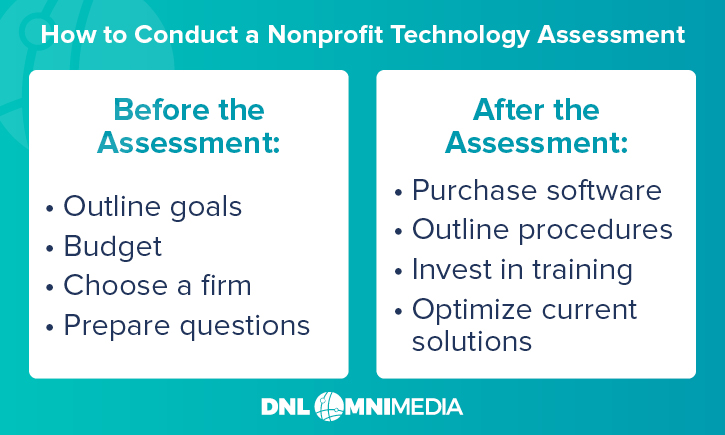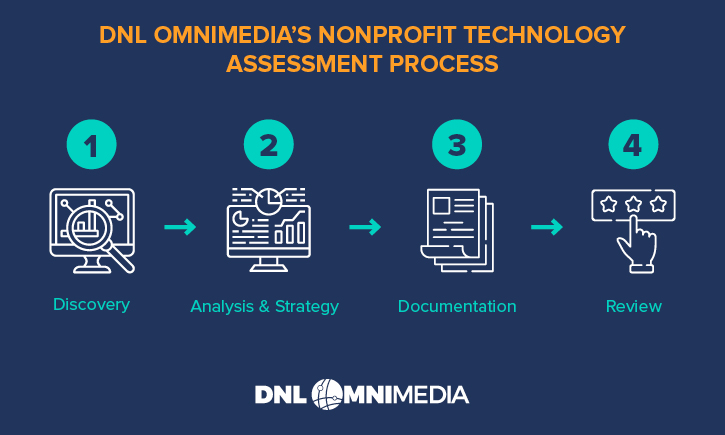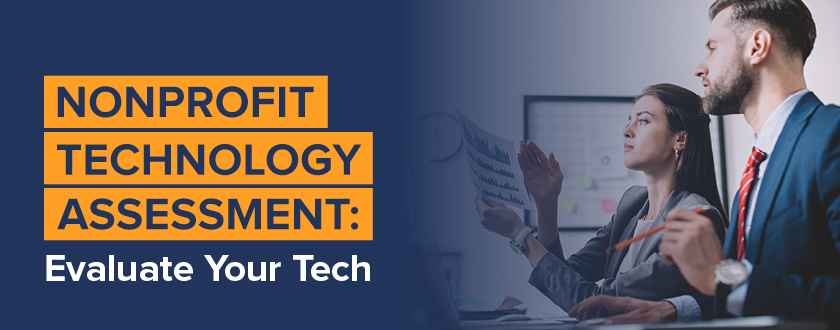
Many nonprofits have relied on technology as a crucial aspect of standing out from the crowd, connecting with donors, and raising the needed donations to further their cause. At this point, the question isn’t whether to use tech but whether your tech stack is configured in a way that positions your organization for success. That’s where a nonprofit technology assessment comes into play.
A nonprofit technology assessment is an evaluation of the digital maturity of your organization. It examines the tech you use and how effectively you use those tools. The end goal is to discover opportunities to optimize your tech stack further.
However, the value in a tech assessment extends beyond discovering gaps in your current tech stack or areas for improvement. You also gain a full picture of the software your team is currently working with, which can inform your fundraising, advocacy, stewardship, and technology-related efforts going forward.
We’re going to walk through the steps of conducting a nonprofit technology assessment through the following points, to give your team a good starting point for optimizing your tech:
- Why should you conduct a nonprofit technology assessment?
- How to Conduct a Nonprofit Technology Assessment
- The Team DNL Technology Assessment Process
At DNL OmniMedia, we work with nonprofits to assess their technology and discover areas for improvement. Over time, we’ve found that the first step to creating an optimized tech stack is developing a clear understanding of the nonprofit’s current tech lineup. So, let’s dive in!

Why should you conduct a nonprofit technology assessment?
A nonprofit tech assessment discovers whether your nonprofit’s use of technology is lagging (behind the times), adapting (caught up, but not innovative), or maturing (ahead of the curve). Nonprofits can be located anywhere on that spectrum— you could be lagging and encountering tech roadblocks or adapting and looking for new ways to stand out from the crowd.

The motivations that lead nonprofits to conduct these assessments, and the results they discover through them, are unique from organization to organization. But, because you’ll be investing in consulting and any new strategies identified in the assessment, it’s important to make sure this process is the right fit for your team before beginning.
So, let’s cover a few signals that might lead your nonprofit to conduct a tech assessment.

Reasons to Conduct a Nonprofit Technology Assessment
Before we dive into the specifics of conducting a nonprofit technology assessment, let’s consider the situations that might lead your nonprofit down that road. Remember— the goal of one of these assessments is to discover areas to optimize your existing tech stack.
That said, here are a few reasons why you might invest in a nonprofit technology assessment:
- You’re not seeing the expected benefits you should be from your current tech solutions.
- You’re looking to cut software costs and decrease expenses.
- Your nonprofit is experiencing stagnation and a general lack of progression.
It’s not always roadblocks that guide a nonprofit to conduct one of these assessments. Your team could also be looking to invest in new tech solutions with the goal of automating and adding efficiency to your operations. In that instance, a tech assessment would help you do so in an informed manner.
For example, let’s say you’re a nonprofit with an effective CRM, online donation platform, and marketing software. These tools are working well for your team and are optimized to manage your team’s current fundraising capacity. However, in the next year, you’re looking to connect with donors and volunteers in new, innovative ways. In this scenario, you may conduct a nonprofit technology assessment to understand how new outreach tools will fit into your tech stack.

What are some common technology challenges for nonprofits?
In the last section, we covered what might lead your team to conduct a nonprofit technology assessment. But what information or new insights will your organization walk away from the assessment with?
Generally, nonprofit tech assessment deliverables include a roadmap of improvements and a plan for implementing them. The results from one of these assessments are likely to be a combination of challenges and opportunities. Here are some common areas where your team may discover tech challenges and areas for improvement:
- Software: For example, have you invested in multiple solutions with duplicate functionality? Do you have effective integrations in place? Do you need to invest in new software to advance your organization’s tech maturity?
- Data: Is your data “clean?” Do you have standardized practices for data management? Are these communicated clearly across your team?
- Procedure: Are there any tech procedures that aren’t clearly outlined or communicated across your team? Are there areas for improvement in your existing processes?
- Training: Does your entire team understand how to interact with the software they need to operate effectively? Do you need to invest in further staff training?
- External: Do your donor and volunteer-facing solutions provide a positive user experience? Are there areas of confusion or disconnect?
Consider the scenario we presented in the last section, of a nonprofit that has a fairly developed tech stack but is seeking areas to engage supporters in new and innovative ways. In this scenario, their challenge is that they need to invest in new software to advance their tech maturity. Their consulting team would evaluate their current lineup and make recommendations, whether expanding the functionality of their current marketing tools or introducing new software into the lineup (like advocacy tools or mobile apps for nonprofits).

How to Conduct a Nonprofit Technology Assessment
Often, nonprofit technology assessments are conducted by technology consultants. However, there are a few tasks for your team to complete before and after the effort:

Before the Assessment
Before the assessment, your team should complete the following tasks:
- Outline your goals for the assessment. What is your main goal for the assessment? Is it to stand out from the crowd, iron out a specific pain point, or simply better understand what current tech solutions you’re working with and how they can be improved?
- Budget for the project accordingly. This budget should include the cost of conducting the assessment itself, such as consulting fees, but also account for any expenditures you might have after the fact. These could include investments in new solutions or additional consulting to improve the tools you’re already working with.
- Choose a firm to conduct the effort. While there are free tools available for your team to conduct a tech assessment, we recommend that nonprofits that are working with robust solutions (such as those provided by Blackbaud or Salesforce) invest in professional tech guidance.
- Prepare questions for your consulting team. Before you begin working with a consultant, you should create a list of your team’s most pressing tech questions. Are there pervasive roadblocks that you continue to run into, or innovative tech solutions that you’re interested in incorporating?
Having a strong understanding of your goals, main pain points, and budget will set clear parameters for the nonprofit technology assessment. Then, share this information with your consulting partner to ensure you’re working from the same foundational understanding from the start.
After the Assessment
After the assessment is complete, your team may receive recommendations involving any of the following efforts:
- Adjusting the solutions in your tech stack. This could mean an investment in new software or even removing solutions that are no longer serving you.
- Outlining new procedures for staff to follow. If you’ve invested in the right solutions but don’t have clear guidance on how to use them, you’ll need to outline clear procedures and share them across your team.
- Investing in staff technology training. Whether you invest in new software or your team is simply not using your current stack effectively, you may need to invest in staff-wide training sessions to bring everyone up to speed. This training could be conducted by a tech consultant or representatives from your tech vendors.
- Optimizing your current solutions. For example, you may need to implement integrations between key software, clean up the data in your database, or customize your solutions to better align their functionality with your goals.
Of course, these tasks can be a big ask for nonprofit professionals that aren’t closely familiar with the intricacies of nonprofit technology. In that instance, you may choose to continue working with the nonprofit tech strategy consultant that conducted your assessment to carry out their recommendations.

The Team DNL Technology Assessment Process
Now that we’ve covered the role your nonprofit plays in the nonprofit technology assessment process, let’s cover the tasks your consulting team will complete.

This is the industry-standard approach for tech assessments. At DNL OmniMedia we build out the process to ensure long-term value for our nonprofit clients, so there’s no better way to cover the process than to walk-through ours.
Timeline
A DNL OmniMedia nonprofit technology assessment tends to run anywhere from six to 12 weeks long. This includes the initial assessment, but ongoing consulting and implementation may continue beyond that period.
Now, let’s dive into the process!

Step One: Discovery
The first step in the DNL OmniMedia nonprofit tech assessment process is Discovery. In this step, we sync with your nonprofit to develop an understanding of your goals and current use of technology.
This involves asking questions such as:
- Who is your organization? This includes an understanding of your organization’s overall mission and the efforts you conduct to advance it.
- Why did you choose to conduct a tech assessment? This could be that you’re experiencing major tech challenges or even that you’re simply looking for a better understanding of your current tech stack.
- What are your goals for this assessment? Are you seeking to overcome a specific tech obstacle, or maybe looking to modernize and stand out in the crowded nonprofit landscape?
- How would you describe your current understanding of technology? For example, your team could be effectively navigating your tech and already picturing areas for improvement. Or, you could be struggling with an inconsistent understanding of your solutions across the team.
A tech assessment involves a close analysis of your entire tech stack, and these questions give us an idea of the areas to pay the closest attention to.

Step Two: Analysis & Strategy
The second step in this process is conducting an analysis of your current software and formulating a strategy to align that technology with your goals.
There are two parts to this, so let’s break them down separately. First, while analyzing your current nonprofit technology, we obtain answers to the following questions:
- What software solutions are you currently using?
- What are you using those solutions for?
- How are those solutions working together?
In this stage, we help guide your team through internal surveys to understand your current use of technology. Then, we use this information to create a digital strategy for improving that technology to meet your goals. This strategy could involve determining:
- Which nonprofit technology solutions to invest/divest in
- Areas where current software can be improved (ex: data hygiene, software integration, customizations)
- Which new policies to implement to ensure the effective use of technology
- Recommendations for additional staff training
In the next section, this information is documented and becomes the main deliverable of the nonprofit technology assessment.

Step Three: Documentation
The third step in our nonprofit technology assessment process is documenting our findings and recommendations. This includes information such as:
- Documentation of all existing technology solutions
- Recommended optimizations for your tech stack
- A roadmap for implementing these optimizations
- Any products to be created or customized in the optimizations (ex: new website, custom mobile app, etc.)
- Goals that these optimizations will achieve
This is a fairly high-level overview of the documentation stage and may not give you the best idea of what your team walks away with. So, let’s examine these deliverables in more detail.
Deliverables
At the end of a DNL OmniMedia nonprofit technology assessment, your team receives two deliverables: a Roadmap and an Implementation plan. Let’s consider an example drawn from a past technical strategy project that Team DNL mapped out and completed to understand what this could include.
Episcopal Relief & Development, a nonprofit that works with church partners and local organizations in nearly 40 countries to rebuild after disasters and fight poverty, hunger, and disease, was looking to undergo a digital transformation.
After a collaborative nonprofit technology assessment, the following information was recorded:
- A report showing their current tech landscape, including gaps, vulnerabilities, and recommended improvements
- 30 software and technologies that the organization was in possession of, but not previously aware of
- A roadmap of potential improvements, including project priorities, budget considerations, and a timeline for the digital transformation
- A technical solution matrix that documented staff usage of software and solution contract terms, for reference prior to future tech investments
Of course, the results of each nonprofit’s technology assessment are unique. So, while these were the results of one nonprofit’s assessment, your organization’s probe could result in very different findings. Regardless, these deliverables are valuable in that they provide a concrete roadmap for improvements and a solid foundation for your team to build upon.

Step Four: Review
The final step in the DNL OmniMedia nonprofit technology assessment process is a review of the assessment and the deliverables available to your team.
We communicate our recommended strategy for improving your nonprofit’s tech stack and discuss the best path forward with your team. Because DNL OmniMedia is an experienced nonprofit consulting firm, we can implement these recommendations for you. So, we also provide a quote for the implementation of the recommended strategy.
This could include any of the following nonprofit technology consulting services:
- Nonprofit Website Development: Whether building your website from scratch or optimizing your current site to align with best practices, we can design an optimal website for your organization.
- CRM and Data Management: We can conduct a painless data migration, build intuitive integrations, and customize your solutions for impactful data collection.
- Fundraising Solutions: We can develop omnichannel fundraising campaigns, donor acquisition campaigns, and even sustainer programs.
- Marketing Solutions: We can create a marketing strategy that includes pay-per-click, social, and organic content marketing. Additionally, we can create marketing collateral to use in those strategies.
- Advocacy Solutions: We can help you select, implement, and customize the ideal solutions for your advocacy program.
- Mobile App Development: We offer a custom mobile app built using the Luminate Online platform to fuel your nonprofit’s fundraising and advocacy needs.
This quote doesn’t mean you have to work with Team DNL to carry out your strategy, and you can gather other quotes if you wish once you have selected the solutions to move forward with. That said, one of the main benefits of working with a tech consultant to conduct your assessment is that they can help you immediately begin acting on their findings. At DNL OmniMedia, we’re proud to serve as long-term partners to help nonprofits.
In conclusion, a nonprofit technology assessment gives your team a thorough understanding of your organization’s digital maturity and how to improve. However, it’s really just a first step in optimizing your tech stack, and you’ll likely want to work with a tech consulting firm to carry out the improvements noted in your assessment.
To learn about conducting your tech assessment with Team DNL, or any of our other services, contact us today. In the meantime, explore the following additional resources to grow your understanding of nonprofit tech:
- Nonprofit Technology: Why, What & How of Smarter Fundraising. There’s a decent chance your tech assessment results will unveil a need to invest in (or divest from) a few nonprofit tech solutions. Explore the many types of nonprofit software that were mentioned in this guide.
- Creating a Nonprofit Digital Strategy: 7 Steps for Success. Digital maturity is more than investing in technology, but having a strategy for how that tech works together. Review this guide to the seven steps to creating a nonprofit digital strategy.
- 5 Reasons to Seek Strategy Consulting for Nonprofit Tech. Are you considering working with a tech consultant to improve your nonprofit’s technology? Explore this guide to five clear areas where a consultant is a valuable resource.


